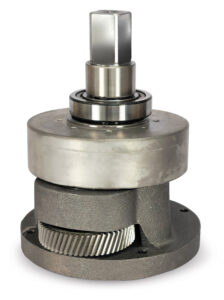A New Generation of Reliable Drum Motors

The new generation of drum motors are engineered to reliably power conveyor belts, operating 80,000 continuous hours, without maintenance. Image courtesy of VDG.
How Engineers Eliminated Heat Issues
By Alexander Kanaris, Founder and President of VDG (Van der Graaf)
The drum motor, used to power conveyor belts since the 1950s, operates safely and is often a space saver. But they haven’t gained traction with the belt conveyor industry because the internally powered conveyor drives tended to overheat. But that changed in mid-2021.
After a significant investment and five years of research and development, engineers uncovered the root cause of the heat issues, and developed a new generation of drum motors designed to operate continuously for 80,000 hours before requiring maintenance.
The drum motor is essentially a motorized pulley system, encapsulated within a steel shell — so there are no external rotating parts, a significant benefit compared to traditional external motor and gear box drives. They are designed to power belt conveyors utilized for a variety of applications including food processing and packaging lines, distribution center and postal operations, the aggregate and mining industries, to name just a few. In fact, you’ve probably experienced an airport baggage conveyer powered by a drum motor.
How do drum motors work?
The drum motor is a one-component conveyor belt drive. An input power cable passes through a hollow shaft, and is connected to the motor stator. The electric motor is mechanically connected in-line to the gear reducer.
The drum motor is partially filled with oil. The oil inside the drum motor lubricates all mechanical components and helps to dissipate heat generated by the electric motor and gear reducer onto the drum, and from the drum to the belt. In theory, the drum motor is cooled by the belt making full contact with the rotating steel drum.
Why is the new drum motor design more reliable?
With the motor and gear reducer in-line, the drum motor eliminates mechanical losses, as is often the case with traditional external motor and gearbox systems. The only mechanical losses are in the gear reducer itself, which is 2% per stage of reduction. The majority of gear reducers are two-stage, with some having three-stages depending on the desired belt speed. As a result, the mechanical losses of the drum motor may range between 4% and 6%, making it the most efficient belt drive on the market today.
What impacted reliability?
Most drum motor failures, regardless of the manufacturer, are related to the inability to extract and dissipate heat generated by the electric motor and the gear reducer.
To obtain some reliability with drum motors used to drive a belt conveyor, the conveyor load could not exceed more than 60% of the drum motor horsepower rating. Anything above that would cause drum motor failure due to heat buildup. These types of failures contributed to the common opinion that the drum motor is not a reliable choice for a conveyor belt drive.

The gear reducer was completely redesigned for increased efficiency and low noise levels. Image courtesy of VDG.
What was causing heat issues?
In the original drum motor design, the gear reducer generated 15% of the overall drum motor temperature, while the electric motor generated the remaining 85%.
Electric motors have two primary heat sources. The heat generated by the electric motor windings due to current density, as well as the heat generated by the stator core and rotor core due to magnetic density.
An external cooling fan is normally an important feature of any standard electric motor, and electric motors will fail if they cannot dissipate the heat generated by the current density and magnetic density. Without a cooling fan, the temperature of the motor keeps increasing to the point of destruction.
However, drum motors do not have a cooling fan. And most of the drum motors sold today are lagged with rubber, making it extremely difficult, if not impossible, to remove heat from the drum motor.
How did the engineers improve the design?
Knowing that a cooling mechanism for a drum motor was not feasible, the design team focused their efforts on designing a drum motor that does not require external cooling.
After an extensive five-year research and development study, we developed an all new drum motor design. Calculating new electric motor windings with reduced magnetic and current densities for low-temperature emissions got us on the right track, but it wasn’t enough to reach the goal.
The metallurgical composition of the stator core and rotor had to be changed, and using material containing less carbon and more iron minimized the decrease in flux densities and reduced losses. High losses actually produce high temperatures, and low losses produce low temperatures.
How did the engineers improve reliability?
The gear reducer had to be completely redesigned for increased efficiency and low decibel noise levels required in a number of industries, primarily the airline industry. Following a complete redesign, all components of the new generation drum motor are also designed for 80,000 hours of continuous operation before maintenance.
This was achieved by reducing the electric motor operating temperature and increasing
the level of lubrication. However, the temperature reduction through minimization of losses only worked for motors up to and including 50 hp. A 75 hp drum motor and higher, regardless of the manufacturer, will fail without an external oil cooler.
Due to the thermodynamic changes that occur in a 75 hp and higher drum motor, an external oil cooler is required to maintain low motor and oil temperature. The research team developed and patented a cooling/conditioning unit that extracts the oil from the drum, filters it, cools it and returns it to the drum motor.
What challenges did the researchers encounter?
In 2012, our research team began investigating how the lack of heat transfer affects the reliability of the drum motor. The findings were not encouraging initially.
Originally, it was thought that oil would transfer heat from the motor and gear reducer to the drum, and from the drum, the heat would dissipate onto the conveyor belt. In order to achieve any heat transfer from the drum motor to the belt, the drum motor could not be covered with rubber lagging.
On a drum motor without lagging and full belt contact, the amount of heat dissipated to the belt was only 26% of the required heat dissipation. When the same drum motor was tested with lagging, there was no measurable heat dissipation. In simple terms, a drum motor with lagging has no cooling.
The second test was with an all-stainless steel drum motor driving a modular Intralox belt.
The results were the same: no measurable amount of heat dissipation was recorded. In that case, the operating temperature of the electric motor with no cooling will continue to rise until the motor burns out. The lifespan of a motor exposed to those conditions and running under full load is unlikely to last more than 10 hours.
Elevated temperatures also affect the lubrication properties of the oil. When the oil is exposed to the high temperature generated by the motor and gear reducer, it reduces the oil viscosity. Test results indicated that when the electric motor reached 100 degrees Celsius, the oil viscosity dropped from 220 centistokes (cSt) to less than 10 centistokes. With 10 centistokes of oil viscosity, the oil is no longer an effective lubricant and could cause gear and bearing damage.
Were there other design improvements?
Since the drum motor is a hermetically sealed unit, the internal pressure can also climb to approximately 18 psi, which reduces the integrity of the oil seals, causes oil leaks, and increases the overall temperature of the drum motor. The calculated maximum operating temperature for acceptable oil viscosity and effective lubrication of the gears and bearings in the drum motor cannot exceed 75 degrees Celsius.
To achieve this goal was a tall order, considering the operating temperature of a standard electric motor is an 80 degree Celsius temperature rise, plus an ambient temperature of 25 degrees Celsius, which brings the overall operating temperature to 105 degrees Celsius.
In the new electric motor designs, the laminated stator core and rotor physical size also had to be taken into consideration, and the length and diameter had to be increased to make up for the horsepower and torque lost by the reduction of the magnetic density. To reduce the operating temperature further, an equalization pressure valve had to be included in the design to prevent pressure build-up in the drum motor.
These design improvements resulted in significantly increased oil seal service life, substantially better sealing, and reduced oil and motor temperatures.
The key takeaways
The engineering team faced a huge challenge in developing and implementing the new motor design. Significant investments along with in-house design and manufacturing of all components, including electric motors and all gear reducers, made it possible for the engineering team to overcome heat issues most drum motors were experiencing.
About the Author
As the founder and president of VDG, Alex Kanaris holds 26 patents in electrical and mechanical conveyor drive designs, including the VDG Drum Motor. For more information, visit www.vandergraaf.com.
NOTE: All of the above drum motor design improvements have been carried out by the VDG research and development team, and all new-generation drum motor components are manufactured by VDG exclusively for VDG Drum Motors. The designs are proprietary to VDG and do not apply to or cannot be followed by any other drum motor manufacturer.








